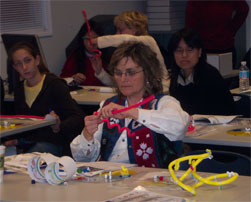
|
|
|
|
|
||
Education Corner: Cheryl Campbell, New Providence High SchoolCheryl Campbell graduated from Boise State University in Idaho in 1982 with a Bachelor of Science degree in Biology, and received her Masters in Teaching Natural Science from Rensselaer Polytechnic Institute in Troy, New York in 2002. After teaching for 13 years in Idaho in a small rural school, she moved to New Jersey and started teaching in New Providence. Through the years, she has taught Biology, Life Science, AP Biology, Honor's Biology, and Environmental Studies.
After the Olympiad, we were still thirsty to learn more from the PDB. So on Wednesday, March 22, 2006, 10 juniors and seniors from New Providence High School (NJ) spent the day at Rutgers University listening and watching as scientists described and demonstrated their research projects.
Next we had a chance to sit down and listen to Dr. Cathy Lawson (Department of Chemistry and Chemical Biology) describe how lysozyme crystals are grown. This was a very complicated talk, and the students were amazed at what the crystals look like and their role in the determination of protein structures.
After lunch, the students met two graduate students in Dr. Kathryn Uhrich's (Department of Chemistry and Chemical Biology) group - Min Jung Song and Jinzhong Wang. These students were the best. They showed us their experiments and talked about scientific discovery. The class saw how the process of learning by performing an experiment, and then rethinking their hypotheses using the results, worked in this laboratory. The day was a great success. Each of my students gained some insight on how real research works. Experiences like this can help energize students to pursue science in their own college education and I would encourage more high school teachers to take advantage of what can be gained by interacting with the information in the PDB. 1 Materials included the Mini-Toobers from 3D Molecular Designs and the MSOE Model Lending Library.
|
||
©2006 RCSB PDB |
 In October of 2005, I happened to notice a presentation on proteins while attending a convention for science teachers in New Jersey. I walked in and heard several people, including Christine Zardecki, talk about protein structure. The hands-on demonstrations with modeling kits
In October of 2005, I happened to notice a presentation on proteins while attending a convention for science teachers in New Jersey. I walked in and heard several people, including Christine Zardecki, talk about protein structure. The hands-on demonstrations with modeling kits We began our day with Dr. David A. Toke, our guide for a walking tour of the Rutgers University Cell and DNA Repository. He expertly described the steps in making cell lines that are being used to learn more about specific genes and their function. His own studies include taking a genetic approach to the study of addiction, longevity and many diseases. The students were particularly amazed at the size of the liquid nitrogen containers and the details required to insure both the privacy of data from human subjects and accuracy of data.
We began our day with Dr. David A. Toke, our guide for a walking tour of the Rutgers University Cell and DNA Repository. He expertly described the steps in making cell lines that are being used to learn more about specific genes and their function. His own studies include taking a genetic approach to the study of addiction, longevity and many diseases. The students were particularly amazed at the size of the liquid nitrogen containers and the details required to insure both the privacy of data from human subjects and accuracy of data.  Dr. Helen M. Berman, the director of the RCSB PDB, gave the students a great history of structural biology and the PDB. It is impressive to think of how much has become understood in the past 35 years.
Dr. Helen M. Berman, the director of the RCSB PDB, gave the students a great history of structural biology and the PDB. It is impressive to think of how much has become understood in the past 35 years.